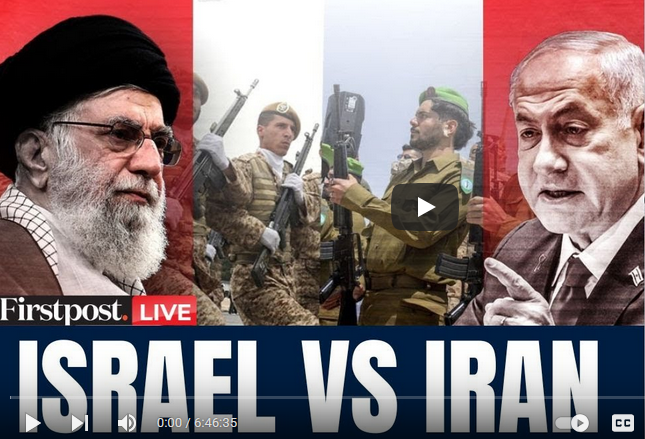The sirens wailed across Israel on that ominous Friday, June 13th, 2025, as Iranian drones and missiles streaked towards their targets. It was Tehran’s direct retaliation for Israel’s audacious strikes earlier on that same Friday that reportedly pierced the heart of Iran’s nuclear program near Isfahan as well as other strategic targets. This exchange, escalating a previous shadow war of assassination of key figures by Israel and covert actions into open, strategic bombardment, felt like a perilous lurch towards an apocalyptic brink. Yet, beneath the terrifying spectacle lies a profound strategic reality: this cycle of violence, while dangerous, is steadily tilting the regional balance of power decisively in Israel’s favor, potentially condemning the Islamic Republic to the very historical obscurity it seeks to avoid through its nuclear ambitions.
Iran’s massive retaliation, while designed to project overwhelming power, ultimately showcased its profound limitations. The overwhelming majority of its drones and missiles estimated above 95% were intercepted by Israel together by a U.S.-led coalition including Jordan, the UK, and France. It was a costly demonstration not of Iranian strength, but of the near-futility of its conventional arsenal against the layered, technologically superior defenses Israel possesses and can mobilize allies to support. Each expensive Iranian projectile destroyed by a relatively cheaper interceptor represents not just a tactical loss, but a draining hemorrhage of scarce resources for an economy buckling under decades of sanctions, rampant inflation, and profound internal discontent. Israel, conversely, fights asymmetrically: its Isfahan strike demonstrated deep intelligence penetration and surgical precision, a stark contrast to Iran’s indiscriminate barrage. The targeted elimination of key nuclear scientists and IRGC commanders further erodes Iran’s strategic depth, forcing it onto a reactive, defensive posture.
The economic chasm between the two adversaries is the anvil upon which Iran’s strategic future is being hammered. Israel, despite its own challenges, possesses a dynamic, technologically advanced economy integrated with the West, capable of sustaining innovation and absorbing shocks. Iran languishes under crippling sanctions; its oil exports throttled, its currency collapsing, its youth increasingly disillusioned and restive. Every billion dollars spent launching largely ineffective salvos or propping up regional proxies like Hezbollah and the Houthis is a billion dollars not spent on Iran’s crumbling infrastructure or feeding its population. This economic suffocation is a slow, inexorable pressure far more damaging than any single Israeli bomb.
Regionally, the tectonic plates are shifting in ways deeply unfavorable to Tehran. The unprecedented sight of Arab states like Jordan actively intercepting missiles, Saudi Arabia and the UAE facilitating intelligence and refueling and effectively siding with Israel against an Iranian attack was revolutionary. It signifies a pragmatic, if unspoken, realignment. The old paradigm of pan-Arab solidarity against the “Zionist entity” is crumbling, replaced by a growing, shared apprehension of Iranian expansionism and nuclear aspirations. Tehran’s vision of leading an “Axis of Resistance” increasingly resembles a march into strategic isolation. Its attempts to project power through proxies are met with growing regional resolve to counter it, often tacitly aligning with Israeli security interests.
This is not to predict Iran’s imminent collapse. The regime possesses potent asymmetric tools. Its proxy network remains dangerous, its cyber capabilities real, and the nuclear question unresolved. Miscalculation remains a terrifying possibility. However, the trendlines are starkly visible. Iran is pouring its dwindling resources into a military contest it is structurally losing. Its retaliatory spectacles are becoming expensive, humiliating exposes of its conventional weakness. Its economy is a millstone dragging down its ambitions. Its regional influence faces an emerging, albeit informal, coalition that views Israeli technological prowess and Western alliances as a necessary counterweight.
I strongly hold the opinion that power is relative and history is a harsh judge of regimes that prioritize ideological confrontation over internal vitality and regional pragmatism. The Islamic Republic, born in revolutionary defiance, now risks becoming an anachronism. Its apocalyptic rhetoric masks a deeper fear: that its true endgame might not be a cataclysmic victory, but a slow, inexorable fade into irrelevance. Its nuclear program, constantly set back by sabotage and assassination, may never deliver the ultimate deterrent. Its economy staggers. Its people chafe. Its regional standing diminishes. Israel, through relentless innovation, strategic patience, potent intelligence, and crucial alliances, is demonstrating that survival and enduring strength belong to the adaptable and the technologically supreme. Tehran’s aggressive posturing may ultimately bury it not under Israeli bombs, but under the shifting sands of history, a once-feared power reduced to a cautionary footnote, its revolutionary fervor consumed by the desert wind of time and its own unsustainable contradictions. The sands of power are shifting, and Iran is on the wrong side of the dune.


